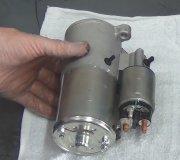Both of those suggest the starter is not drawing enough current. The battery's voltage should be getting drawn down more than that. One worn brush of the four in the starter can cause this. The starter motor is electrically two motors in one housing. When one part fails, the other will crank the engine too slowly and it will initially draw only half of normal current.
To confuse the issue, a GM or Ford V-8 starter will draw in the area of 300 amps at first. Once it is spinning, it generates a voltage, just like a spinning generator, that opposes battery current. That results in battery current dropping to around 225 - 250 amps once the starter is spinning. With half of the motor not working, it will draw about 150 amps initially, then, since it's spinning too slowly to generate that reverse voltage, current stays near 150 amps.
Those numbers are approximate, and it is why a partially-failed starter can be so hard to diagnose. The current draw for a starter with one bad brush is close to the same as for a good starter spinning at normal speed.
Assuming your replacement starter is okay, the next suspect is an excessive voltage drop across a loose or dirty connection. To start finding that, put one voltmeter probe on the positive battery post, (not the cable clamp attached to that post), and put the other probe on the stud on the starter solenoid, (not the terminal bolted to it). If you have GM's miserable side-post battery, you just have to put that probe on the 5/16"-head bolt and hope for the best. These two points are the same points electrically in the circuit so the voltmeter will read 0.00 volts. Now take that same reading while a helper cranks the engine. If there is any undesirable resistance in that cable and its connections, the results of that resistance will show up as a voltage reading. The maximum allowable is 0.40 volts in the entire circuit.
Do the same on the negative half of the circuit. Put one meter probe on the negative battery post and the other probe on a paint-free point on the engine block. 0.04 volts is the most you are allowed during cranking. If either reading is too high, we can narrow it down with additional tests.
Do you have a side-post battery or one with posts on top?
Tuesday, February 7th, 2017 AT 3:39 PM



